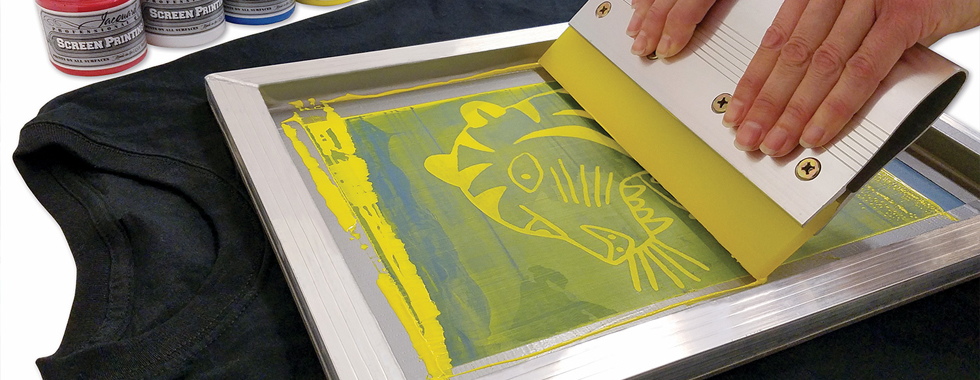The Important Guide to Comprehending Screen Printing and Its Versatile Uses
Screen printing has an abundant history that goes back to ancient times, progressing into an innovative technique made use of across numerous industries today. This overview discovers the ins and outs of the screen printing procedure, outlining its applications in home, advertising, and fashion style - 10:9 Design LLC Company. Recognizing these fundamentals can open up innovative possibility for both business and artistic jobs. The following areas will disclose vital pointers and strategies to improve one's screen printing undertakings
The History of Screen Printing
Although screen printing has roots that map back centuries, its evolution reflects the artistic and technical improvements of numerous societies. Coming from in ancient China, the method was originally made use of for decorating textiles and later infect Japan, where it became important to Ukiyo-e woodblock printing. The approach changed to Europe in the 18th century, where it gained appeal amongst craftsmens and industrial printers. The innovation of photo emulsion in the 20th century reinvented screen printing, enabling even more detailed designs and better performance. Artists like Andy Warhol additionally propelled its appeal, utilizing the tool to create famous jobs that mixed commercialism and fine art. By the late 20th century, screen printing had established itself as a versatile method, employed in style, advertising and marketing, and art. Today, it remains to progress, integrating digital modern technology and broadening its applications across numerous sectors.
The Screen Printing Process Explained
Screen printing changes creative visions into substantial styles through a collection of accurate actions. A picture is created and after that transferred onto a screen, normally made of fine mesh textile stretched over a structure. A light-sensitive emulsion is used to the screen, which is exposed to light, setting in areas not covered by the picture. After washing out the unhardened emulsion, a pattern is formed.
Next off, the screen is placed over the substratum, whether it be fabric, paper, or one more product. Ink is then pressed through the open areas of the pattern using a squeegee, depositing the layout onto the substrate listed below. This procedure can be repeated for several shades, requiring separate displays for each shade. The printed product is cured utilizing warmth to guarantee the ink adheres appropriately, resulting in a sturdy, vibrant style prepared for usage.
Kinds of Screen Printing Techniques

Additionally, specialized strategies, such as discharge screen printing, eliminate color from the fabric to develop softer prints, while foil screen printing applies metal foil to accomplish a glossy finish (10:9 Design Texas). Each strategy offers unique attributes, satisfying numerous creative requirements and manufacturing ranges, ultimately broadening the opportunities within the screen printing domain name
Applications of Screen Printing in Different Industries

Furthermore, the signs and advertising industries make use of screen printing for developing distinctive displays and banners. This technique enables vibrant shades and intricate styles that catch focus. In electronic devices, screen printing is used for applying conductive inks to circuit boards, necessary for component connections. The home decoration sector welcomes screen printing to generate distinct layouts on fabrics and wall surface art. On the whole, screen printing acts as a crucial tool across diverse fields, enhancing items with individualized and aesthetically enticing graphics.
Tips for Effective Screen Printing Projects
While undertaking a screen printing project, mindful focus to information can substantially improve the final result. Choosing premium materials is important; this includes the screen, inks, and substratums. Utilizing suitable mesh counts can influence ink deposition and information resolution. Preparation is equally vital; detailed cleansing of screens and proper direct exposure times ensure crisp prints.
Next, exact registration is crucial for multi-color prints. Utilizing placement tools can aid accomplish accurate layering. Additionally, screening prints on scrap materials before production aids determine potential issues without throwing away sources.

Frequently Asked Questions
What Materials Are Ideal for Screen Printing on Textile?
Cotton and polyester blends are excellent for screen printing on fabric as a result of their durability and ink absorption. Additionally, here specialized materials like silk or canvas can create distinct textures and coatings, boosting the general style quality.
Just how Do I Tidy and Maintain Screen Printing Devices?
To keep and clean up screen printing equipment, one need to consistently clean screens with appropriate solvents, evaluate squeegees for wear, lubricate relocating parts, and shop all products in a dry, dust-free setting to extend their lifespan.
What Are the Ecological Effects of Screen Printing?
Screen additional info printing can have significant ecological effects, including chemical waste from solvents and inks, water usage throughout cleaning processes, and power consumption. Lasting techniques and green materials are vital for minimizing these unfavorable results.
Can Screen Printing Be Done in your home Successfully?
Screen printing can be successfully done at home with the best products and strategies. Hobbyists can produce quality prints, though success depends upon their ability degree, tools, and understanding of the process involved.
What Are the Expenses Related To Starting a Display Printing Company?

Starting a screen printing service entails costs for equipment, materials, and work area. Preliminary expenditures generally range from a few hundred to a number of thousand bucks, relying on the scale, quality of machinery, and desired production capacity.
Screen printing has a rich history that dates back to ancient times, developing into an article advanced method utilized across different markets today. One more technique, rotary screen printing, employs cylindrical displays, facilitating continuous printing on fabric rolls, thereby boosting performance for large-scale productions. Additionally, specialized strategies, such as discharge screen printing, get rid of color from the material to produce softer prints, while foil screen printing uses metal aluminum foil to accomplish a shiny coating. In the style market, screen printing is commonly used to create vivid styles on clothing, enabling brand names to display their special styles. Cotton and polyester blends are perfect for screen printing on fabric due to their durability and ink absorption.